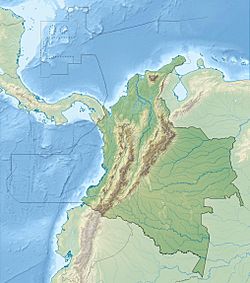Hunzahúa Well facts for kids

Hunzahúa, after whom the Well was named
|
|
| Location | Tunja, Boyacá |
|---|---|
| Region | Altiplano Cundiboyacense, |
| Coordinates | 5°33′13.92″N 73°21′22.44″W / 5.5538667°N 73.3562333°W |
| Altitude | 2,715 m (8,907 ft) |
| Type | Mythological site |
| Part of | Universidad Pedagógica y Tecnológica de Colombia Muisca sites |
| History | |
| Abandoned | Spanish conquest |
| Periods | Late Muisca |
| Cultures | Muisca |
| Satellite of | Hunza |
| Site notes | |
| Public access | Yes |
The Hunzahúa Well (in Spanish: Pozo de Hunzahúa) is an important archaeological site. It was created by the Muisca, an ancient civilization in Colombia. You can find the well in the city of Tunja, in the Boyacá region.
Long ago, Tunja was known as Hunza. The well gets its name from Hunzahúa, who was the first zaque (ruler) of Hunza. For a while, people called it Pozo de Donato after Jerónimo Donato de Rojas, who lived in the 1600s. Today, the well is located on the campus of the Pedagogical and Technological University of Colombia in Tunja. Experts like Javier Ocampo López and Pedro Simón have shared a lot about the well and its interesting myths.
The Muisca People
Before the Spanish arrived, the high plains of the Colombian Andes mountains were home to the Muisca people. This advanced civilization had its own unique beliefs and ceremonies. Their religion focused on important gods like Sué (the Sun god) and Chía (the Moon goddess).
The Muisca lands were divided into different areas, each with its own leader. In the northern parts, there were rulers called the iraca of Sugamuxi, the tundama of Tundama, and the zaque who ruled from Hunza (modern-day Tunja).
The Myth of Hunzahúa Well
The Hunzahúa Well is famous for a special Muisca myth. It tells the story of Hunzahúa, who was the first zaque of Hunza. He had an older sister named Noncetá.
According to the legend, Hunzahúa and Noncetá did something that angered their mother very much. In her anger, their mother threw a stick at them. The stick missed the siblings but hit the ground, causing chicha (a traditional drink) to spill. This spilled chicha then formed the Hunzahúa Well.
After this event, Hunzahúa and Noncetá fled from Hunza. They traveled to a place called Susa. Later, they continued their journey south into the lands of the zipa (another Muisca ruler). They eventually reached the Tequendama Falls. There, feeling tired and sad, they hid in the woods and, according to the myth, turned into two stones.
Hidden Treasure of Quemuenchatocha
Many years after the myth of Hunzahúa, another zaque of Hunza named Quemuenchatocha ruled. When the Spanish conquistadors arrived, Quemuenchatocha decided to hide his valuable treasures. These treasures were mainly made of gold and emeralds. He chose the Hunzahúa Well as the perfect hiding spot.
Later, Donato de Rojas, who the well was briefly named after, ordered his men to try and find Quemuenchatocha's hidden treasures. However, they searched without any luck.
Over time, more mysterious stories grew around the well. Some people believed it was so deep that it had no bottom. Others thought it was connected by a secret tunnel to the cathedral in Tunja!
See also
 In Spanish: Pozo de Hunzahúa para niños
In Spanish: Pozo de Hunzahúa para niños
- Hunzahúa
- Muisca religion
- Muisca mythology
- Cojines del Zaque
- Piedras del Tunjo Archaeological Park
- Sun Temple (Sogamoso)
- Moon Temple (Chía)


